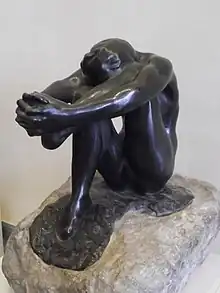| Despair | |
|---|---|
 A bronze cast of the sculpture in a marble base at the Musée Rodin | |
| Artist | Auguste Rodin |
| Year | c. 1890 |
Despair (French: Le Désespoir) or Despair at the Gate (French: Désespoir de la Porte) is a sculpture by Auguste Rodin that he conceived and developed from the early 1880s to c. 1890 as part of his The Gates of Hell project. The figure belongs to a company of damned souls found in the nine circles of Hell described by Dante in The Divine Comedy.[1][2] Other title variations are Shade Holding her Foot, Woman Holding Her Foot, and Desperation (French: Les Désespérés).[3][4] There are numerous versions of this work executed as both plaster and bronze casts and carved marble and limestone.[5][6]
History and description
_by_Rodin_2.jpg.webp)
In the 1880s, Rodin created an initial version that was more upright and whose extended leg was almost vertical. This version of the figure appears several times in the right panel of The Gates of Hell.[7] Rodin returned to the figure around 1890. This time, the woman's extended leg is horizontal and she is clasping her left foot with both hands.[8] This version of the figure is found in the upper left panel of The Gates of Hell.[3]
When it was first exhibited as a stand-alone work, the statue was named Shade Holding Her Foot. However, the unusual acrobatic pose doesn't correspond to any passage in The Divine Comedy or any other work of literature. It is more likely that Rodin just captured a moment when a tired model was stretching to relax her neck or back.[8] When viewed from the side, the figure suggests a truss with triangular units.[9]
It wasn't until 1900 that Rodin began describing the work as Despair.[1][8]
Copies
There are over a dozen versions of the work in several mediums at the Musée Rodin.[4][10] Other copies of the work can be found at:
- Victoria and Albert Museum, London[11]
- Metropolitan Museum of Art, New York[12]
- Maryhill Museum of Art, Maryhill, Washington[13]
- Brooklyn Museum, New York[7]
- National Museum of Western Art, Tokyo[14]
- Stanford University, Stanford, California[15]
- Rodin Museum, Philadelphia[16]
See also
Notes
- 1 2 "Despair". Musée Rodin. Retrieved 2019-09-08.
- ↑ "Désespoir, grande modèle (version avec base découpée sur socle de marbre)". Sotheby's. Retrieved 2019-09-08.
- 1 2 Elsen & Jamison 2003, p. 258.
- 1 2 "'Désespérés' search result". Musée Rodin. Retrieved 2019-09-08.
- ↑ "Désespoir de la Porte (Despair, from the Gates of Hell)". Bowman Sculpture. Retrieved 2019-09-08.
- ↑ Elsen & Jamison 2003, p. 261.
- 1 2 "Despair, Known as Despair from the Gates (Le Désespoir dit de la Porte)". Brooklyn Museum. Retrieved 2019-09-08.
- 1 2 3 Elsen & Jamison 2003, p. 259.
- ↑ Lampert 1986, p. 83.
- ↑ "'Désespoir' search result". Musée Rodin. Retrieved 2019-09-08.
- ↑ "Despair". Victoria and Albert Museum. Retrieved 2019-09-08.
- ↑ "Despair". The Met. Retrieved 2019-09-08.
- ↑ "Museums 101: Rodin at Maryhill (Photo Diary)". Daily Kos. August 21, 2017. Retrieved 2019-09-09.
- ↑ "Despair". National Museum of Western Art. Retrieved 2019-09-09.
- ↑ "Despair (L'désespoir)". Cantor Arts Center. Retrieved 2019-09-09.
- ↑ "Despair". Rodin Museum. Retrieved 2019-09-08.
References
- Elsen, Albert E; Jamison, Rosalyn Frankel (2003). Rodin's Art: The Rodin Collection of Iris & B. Gerald Cantor Center of Visual Arts at Stanford University. New York: Oxford University Press. ISBN 0198030614. Retrieved 2019-09-08.
- Lampert, Catherine (1986). Rodin: Sculpture & Drawings. New Haven, CT: Yale University Press. ISBN 0300038321. Retrieved 2019-09-08.
External links
 Media related to Despair by Auguste Rodin at Wikimedia Commons
Media related to Despair by Auguste Rodin at Wikimedia Commons